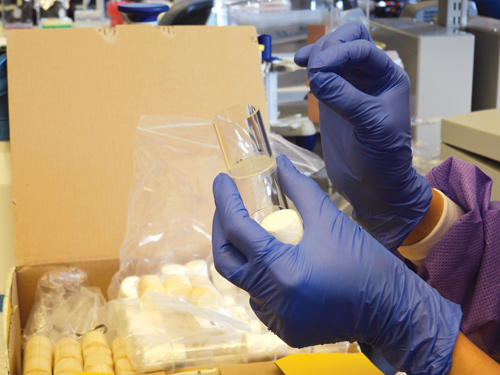
July 18, 2025 — While studying infectious disease as an undergraduate at the University of New Hampshire, Dr. Nicholas Mantis found his calling.
“I learned through a combination of coursework and lab experience that infectious diseases are an interplay between the pathogen and the host,” Dr. Mantis said. “And that the outcome of a disease is largely dictated by your immune response. I just became fascinated with that whole interaction.”
Dr. Mantis, a research scientist and PEF member in the Division of Infectious Diseases at the Wadsworth Center since 2004, was recently awarded a five-year, $9 million contract by the National Institute of Allergy and Infectious Diseases (NIAID) to study human antibody responses to the Lyme disease pathogen, Borrelia burgdorferi.
“The bacterium is initially deposited in your skin at the site of a bite, and then it spreads through the skin and then through the bloodstream, then to organs, including the brain,” he said. “During the course of that, you’re mounting an active immune response. The question is: why do some individuals clear the infection very quickly and other people will have prolonged symptoms, and some will have persistent symptoms even after antibiotic treatment?”
Answering those questions could have a significant impact, especially in localities plagued by an abundance of ticks.
“We really think it’s the decisions, if you will, made by the immune response during those early events that dictate the outcome,” Dr. Mantis said. “That’s our main focus. Our goal would be some kind of preventative that could be in the form of a vaccine or possibly even finding treatments for individuals who suffer from persistent symptoms associated with Lyme.”

While Dr. Mantis spends much of his time in his office working on manuscripts, grant applications and administrative tasks, lab technicians and research scientists in his group focus closely on the ticks themselves, which they obtain from a national biorepository and import into the lab for study.
“We can take ticks and infect them with the bacteria in the lab and then put them in an infection model,” he said. “We can either use artificial feeding chambers or we have a system that mimics human skin and they’ll feed on that.”
The lab also does mouse studies, pre-treating mice with different antibodies, putting the ticks on the mice, and then seeing if the mice get infected. Those projects can be a month long and require daily monitoring. Some of the samples in the lab are human, collected in collaboration with Albany Medical Center. Research staff can profile those samples and look at the differences between the patients who are healthy and those who exhibit Lyme symptoms. Samples range from children to adults and of varying ages and demographics.
The research done in the Mantis Laboratory could also improve outcomes for other tickborne illnesses carried by the black-legged tick, including babesiosis, anaplasmosis, and ehrlichiosis, to name a few.
“I think the mechanisms of transmission are similar, and the immune pathways are shared,” Dr. Mantis said. “So, understanding one, the borrelia infection, will probably lead to understanding of the other pathogens, how they are transmitted and how immunity arises.”
Securing the contract
When the National Institutes of Health released a solicitation for research relating to understanding human antibody responses in general, to allergies, food allergies, autoimmunity, and infectious diseases, Dr. Mantis and colleagues put together their proposal to study Lyme and submitted it through a competitive process.
“Our proposal was obviously focused on Lyme disease, but it’s actually a multidisciplinary program,” he said. “It’s based here at the Wadsworth Center, but we have collaborators at New York Structural Biology Center in Manhattan, the University of Massachusetts Medical School in Worcester, Mass., the University of Washington in Seattle, and a company in San Diego. It was a very competitive award.”
Dr. Mantis said the five-year contract, in this political climate of federal cuts, is vital to the success of the research.
“Virtually everybody’s career in the lab and in the Center is supported through federal research grants,” he said. “I want to stress that maintaining that sustained effort and support from the federal government is critical to Lyme disease research and research into virtually every disease.”
Interested in research?
For aspiring scientists, Dr. Mantis said the lab welcomes high school students during the summer, who they pair with a University of Albany program.
“The program actually gives you credit and a structure in which to start your research career in high school,” he said. “I would also stress to students that science these days is multidisciplinary, so anybody who’s interested in computers or bioinformatics or immunology or infectious disease, there is a place for you.”
Dealing with ticks at home
Department of Health staff, along with public health partners, are in the process of collecting ticks to assemble data for this spring but emphasize that it only takes one tick bite to result in infection — so whether tick populations are high or relatively low, prevention recommendations remain the same and New Yorkers should take precautions to prevent tick bites.
Deer ticks live in shady, moist areas and will cling to tall grass, brush and shrubs, usually no more than 18 to 24 inches off the ground. They also live in lawns and gardens, especially at the edges of woods and around stone walls. They can’t jump or fly and won’t drop onto pets or people. Once a tick gets on the skin, it generally climbs upward until it reaches a protected area.
Ways you can protect yourself
- Wear light-colored clothing with a tight weave to spot ticks easily.
- Wear enclosed shoes, long pants and a long-sleeved shirt. Tuck pant legs into socks or boots and shirt into pants.
- Check clothes and any exposed skin frequently for ticks while outdoors.
- Consider using insect repellent.
- Stay on cleared, well-traveled trails. Walk in the center of trails. Avoid dense woods and bushy areas.
- Avoid sitting directly on the ground or on stone walls.
- Keep long hair tied back, especially when gardening.
- Bathe or shower as soon as possible after going indoors (preferably within two hours) to wash off and more easily find ticks that may be on you.
- Do a final, full-body tick check at the end of the day (also check children and pets) and remove ticks promptly.
According to NYSDOH, the three most common ticks in New York are the deer (black-legged) tick, the American dog tick and the lone star tick. Only deer ticks carry Lyme bacteria. Young deer ticks, called nymphs, are brown and the size of poppy seeds. Adult female deer ticks are red and black, and males are black. Adult deer ticks are about the size of a sesame seed.
Dr. Mantis spoke to us at his lab in the Wadsworth Center about his groundbreaking research.

